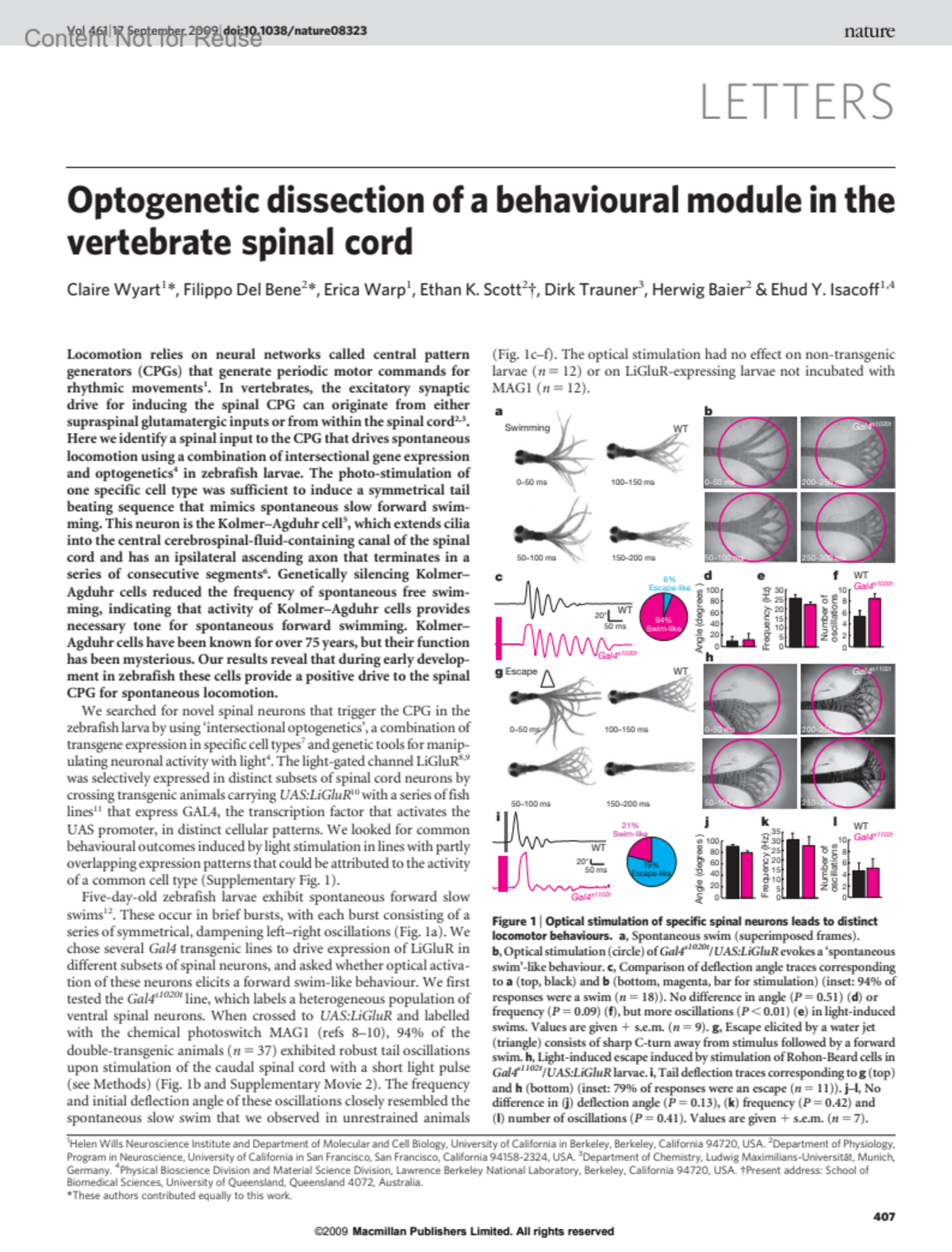Optogenetic dissection of a behavioural module in the vertebrate spinal cord
- Wyart, Claire
- Bene, Filippo Del
- Warp, Erica
- Scott, Ethan K.
- Trauner, Dirk
- Baier, Herwig
- Isacoff, Ehud Y.
1Helen Wills Neuroscience Institute and Department of Molecular and Cell Biology, University of California in Berkeley, Berkeley, California 94720, USA
2Department of Physiology, Program in Neuroscience, University of California in San Francisco, San Francisco, California 94158-2324, USA
3Department of Chemistry, Ludwig Maximilians-Universität, Munich, Germany
4Physical Bioscience Division and Material Science Division, Lawrence Berkeley National Laboratory, Berkeley, California 94720, USA
5These authors contributed equally to this work.
6Present address: School of Biomedical Sciences, University of Queensland, Queensland 4072, Australia.
Correspondence and requests for materials should be addressed to E.Y.I. ([email protected]) or H.B. ([email protected]).
Received 06 March 2009; accepted 27 July 2009
Acknowledgements We thank M. Volgraf for MAG-1 synthesis, K. Kawakami for the UAS:TeTxLC-CFP line, B. Appel for the Olig2-DsRed line, W. Staub for animal care, D. Li for help with screening BGUG larvae, B. Vigh, C. Girit, E. Brustein, P. Drapeau and S. Hugel for discussions, P.G. de Gennes and Noam Sobel for support and O. Wyart for aesthetic input. We are grateful to K. Best, P. Tavormina, H. Aaron, R. Ayer, B. Nowak and M. Ulbrich for advice on the design of the photostimulation setup. Support for the work was from the Marie Curie Outgoing International Fellowship (with the CNRS - UMR5020 ‘Neurosciences Sensorielles, Comportement Cognition’ laboratory, Lyon, France) (C.W.), the Human Frontier Science Program Long-term Postdoctoral Fellowship (F.D.B.), the National Institutes of Health Nanomedicine Development Center for the Optical Control of Biological Function (5PN2EY018241) (E.Y.I., D.T. and H.B.), the Human Frontiers Science Program (RGP23-2005) (E.Y.I. and D.T.), the Lawrence Berkeley National Laboratory Directed Research and Development Program (E.Y.I. and D.T.), R01 NS053358 (H.B.) and a Sandler Opportunity Award (H.B.).
Author Contributions C.W., F.D.B, H.B. and E.Y.I. made critical primary contributions to this study. C.W. built the photostimulation setup, performed behavioural experiments, lesions, pharmacology, calcium imaging, imaging of the immunolabelled larvae, anatomical analysis based on BGUG imaging and wrote the Matlab scripts for analysing behaviour and imaging. F.D.B. generated the transgenic lines UAS:LiGluR10 and Hb9:Gal4, as well as performing the immunochemistry experiments. E.W. participated in the anatomical analysis of BGUG. E.K.S. and H.B. generated the enhancer trap Gal4 screen, which made the ‘intersectional optogenetic’ approach possible11. E.Y.I. and D.T. developed chemical optogenetics with LiGluR8. C.W. and E.Y.I. wrote the manuscript with feedback from H.B. and F.D.B. H.B. and E.Y.I. supervised C.W. and F.D.B. and contributed to the planning of all aspects of this project.

